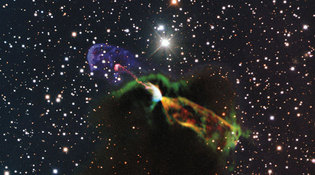 loading
loading
FindingsBaby pictureA telescope captures a newborn star.  ESO/ALMA (ESO/NAO/NRAO)/H. ArceView full imageThis remarkably detailed image of the environment surrounding a newborn star, taken with one of the world’s most powerful new telescopes, shows that the process of star formation is more tumultuous than previously observed. Héctor G. Arce, associate professor of astronomy, and his team captured this image with Chile’s Atacama Large Millimeter/submillimeter Array (ALMA) telescope, which became operational in 2011. (Their report appeared in the September 1 issue of the Astrophysical Journal.) The image shows a nascent star emitting two high-velocity jets of gas. (The nebulous emission arising from the interaction of a jet from a newborn star and its environment is called a Herbig-Haro object; this one is Herbig-Haro 46/47.) ALMA allowed Arce and his colleagues to penetrate the dark fog around the star and observe both jets, one traveling toward the Earth and the other traveling away—at speeds of more than 100,000 miles per hour. Arce believes his finding was just the beginning of the “many surprises and fascinating discoveries” that ALMA will produce.
The comment period has expired.
|
|